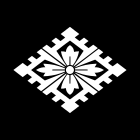Ōuchi clan (
| Ōuchi | |
|---|---|
 The emblem (mon) of the Ōuchi clan | |
| Home province | Suō |
| Parent house | Baekje Royal House (according to tradition) Tatara clan ( |
| Titles | Various |
| Founder | Ōuchi Morifusa ( |
| Final ruler | Ōuchi Yoshinaga |
| Founding year | 12th century |
| Dissolution | 1557 |
| Ruled until | 1557, Ōuchi Yoshinaga commits seppuku |
History
editLocal legend in modern Yamaguchi City has it that the Ōuchi clan were of Korean origins, specifically descended from a prince of Baekje. The Ōuchi-shi Jitsruroku (
Historically the Ōuchi clan emphasized their Korean heritage along with their Japanese identity to establish economic power based on international trade and wield political power.[5] Based in Suō Province, towards the western end of Honshū, the Ōuchi were among the primary families to be involved in foreign trade and relations, particularly with China. Following the Ōnin War (1467–1477), a strong rivalry developed between the Ōuchi and the Hosokawa family, who were then in power. The two clashed at Ningbo in 1523, and as a result the Chinese closed Ningbo to Japanese traders. After the incident, the Ōuchi ships were only allowed to trade in China in 1540 and 1549. The Ōuchi also housed the Portuguese Jesuit missionary Francis Xavier for a time in 1551.
As a result of their wealth and trading contacts, the Ōuchi gained renown in the worlds of art and culture as well. They possessed countless items of cultural and artistic significance and beauty, from Japan and China, as well as from further abroad. Particularly famous was the invitation by Ōuchi Masahiro of the famous painter Sesshū to Yamaguchi in 1486.
In 1551, the daimyō Ōuchi Yoshitaka tried to move Emperor Go-Nara and his court from war-torn Kyoto to Yamaguchi. But the Ōuchi's chief military vassals opposed this plan, fearing that imperial courtiers would displace them. This led to the Tainei-ji incident, in which Yoshitaka was forced to commit suicide.[6] Sue Harukata, the leader of the rebellion, installed Ōuchi Yoshinaga as a puppet clan chief, but Yoshinaga was actually the younger brother of long-time Ōuchi rival Ōtomo Sōrin. This ended the Ōuchi line proper.
In 1555, Mōri Motonari, another former vassal of Yoshitaka, defeated Sue Harukata in the Battle of Miyajima. Two years later, Yoshinaga committed suicide, ending the Ōuchi clan.[7]
Clan heads
edit- Ōuchi Morifusa (
大内 盛 房 ) - Ōuchi Hiromori (
大内 弘 盛 ) - Ōuchi Mitsumori (
大内 満 盛 ) - Ōuchi Hironari (
大内 弘 成 , ? –1244) - Ōuchi Hirosada (
大内 弘 貞 , ? –1286) - Ōuchi Hiroie (
大内 弘 家 , 1274?–1300) - Ōuchi Shigehiro (
大内 重弘 , ? –1320) - Ōuchi Hiroyuki (
大内 弘幸 , ? –1352) - Ōuchi Hiroyo (
大内 弘世 , 1325–1380) - Ōuchi Yoshihiro (
大内 義弘 , 1356–1400) – Led a revolt against Shogun Ashikaga Yoshimitsu. - Ōuchi Moriharu (
大内 盛見 , 1377–1431) - Ōuchi Mochiyo (
大内 持世 , 1394–1441) - Ōuchi Norihiro (
大内 教 弘 , 1420–1465) - Ōuchi Masahiro (
大内 政弘 , 1446–1495) – one of Yamana Sōzen's chief generals in the Ōnin War. - Ōuchi Yoshioki (
大内 義興 , 1477–1529) – Restored the shogun Ashikaga Yoshitane to power after a fifteen-year absence in 1508. - Ōuchi Yoshitaka (
大内 義隆 , 1507–1551) – The lord who oversaw the height of Ōuchi power and saw it end abruptly. - Ōuchi Yoshinaga (
大内 義長 , 1532?–1557) – The last Ōuchi lord, he was the son of Sengoku daimyō, Ōtomo Yoshiaki, and thus not of Ōuchi blood.
Notable retainers
editProminent castles
edit- Ōuchi-shi Yakata : Ōuchi clan's main bastion
- Kōnomine Castle : Supporting castle of Ōuchi-shi Yakata
- Wakayama Castle : Sue clan's main bastion
- Katsuyama Castle
- Tsuwano Castle
- Tsuchiyama Castle
Notes
edit- ^
近藤 清 石 (Kondō Kiyoshi) (1885).大内 氏 実録 (Ōuchi-shi Jitsruroku ).(National Diet Library) - ^ Zhang 2016, p. 74.
- ^
下松 市 史 通史 編 (in Japanese). Kudamatsu. 1989. pp. 112–113. - ^ KBS 역사추적 – 1,400년 만의 귀향, 오우치가의 비밀 / KBS 2009.6.8 방송, retrieved 2023-01-11
- ^ Conlan, Thomas D. (2024). Kings in All but Name: The Lost History of Ouchi Rule in Japan, 1350-1569. Oxford University Press (published January 24, 2024). ISBN 978-0197677339.
- ^ Conlan, Thomas (2015). "The Failed Attempt to Move the Emperor to Yamaguchi and the Fall of the Ōuchi". Japanese Studies. 35 (2): 194. doi:10.1080/10371397.2015.1077679. S2CID 143369274. Retrieved 6 March 2016.
- ^ "
大内 義長 (読 み)おおうち よしながデジタル版 日本人 名 大 辞典 +Plus「大内 義長 」の解説 ". kotobank. Retrieved 21 October 2021.
References
edit- Sansom, George (1961). A History of Japan: 1334–1615. Stanford: Stanford University Press.
- Sansom, George Bailey (1962). Japan: A Short Cultural History. New York: Appleton-Century-Crofts, Inc.
- Turnbull, Stephen (1998). The Samurai Sourcebook. London: Cassell & Co.
- Zhang, Yuling (March 2016). "The Expansion and Specialization of the Matsuri in Regional Cities: Focusing on the Idea of Ohuchi Clan Origins and Its Appropriation in the Yamaguchi Tanabata Lantern Festival" (PDF). Kokusai Bunka Gakubu Kiyō (in Japanese). 22 (1). Yamaguchi Prefectural University: 71–86. Retrieved 2018-01-27.